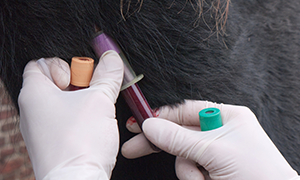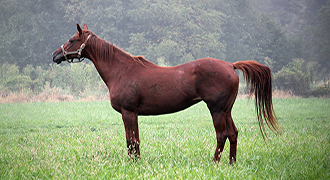
It’s in the blood
Whether animal or human, blood is essential. It’s an ingenious transport system, transferring oxygen from the lungs to all t...
23 April 2020
Read More
We all love big-hearted horses – believing them to be kind, bold steadfast and willing to try their best with whatever the rider asks. But what does this term really mean and what is the true size of a horse’s heart? Are some bigger than others and how hard do they have to work to keep our amazing equine athletes in action?
Heart size
The average horse’s heart is the size of a large melon and weighs around 8-10lbs which is equivalent to the weight of a small dog. In some cases they can weigh double this but it doesn’t always mean that the horse will be a better performer – many other factors have to be considered when it comes to the athletic ability of our equine friends.1,2,3
Heart work
The heart is a muscle and it contracts in a rhythmic cycle – giving it a distinctive beat.4 In the horse it is a cone-shaped organ, broad at the top and with the tip lying near the horse’s sternum.
It has four chambers. Blood enters the heart via the right atrium and flows into the right ventricle. From here the pulmonary artery takes it to the lungs where it is oxygenated before entering the left atrium and then the left ventricle. It is then pumped round the horse’s body via the aorta at a rate of around 35 litres per minute at rest. 3,4
Heart power
A fit, healthy adult horse will have a resting heart rate of 24-40 beats per minute (bpm) http://live-uk-horsedialog.ztsaccess.com/Health/Monitoring-your-horse_s-heart-rate.aspx
The horse’s heart is extremely efficient and powerful with the capacity to pump a massive volume of blood per minute (cardiac output): It can work from resting rate all the way up to 240bpm when galloping. The speed at which it returns to resting is an indicator of fitness and this is used in sports such as endurance to check a horse’s capacity to continue with the competition.3,4
Heart problems
Common cardiac problems affecting horses are murmurs and arrhythmias.3
Murmurs are prolonged vibrations, audible with a stethoscope which occur during normally silent periods of the heart cycle. In general, murmurs are manifestations of either normal (functional) or abnormal (pathologic) blood flow in the heart and blood vessels. There are several different types and many different causes of heart murmurs; those due to normal blood flow (functional) are unlikely to impact performance while others, caused by structural changes and abnormal blood flow, can be much more serious.5,6
Arrhythmia is a variation of the heart’s rhythm. Some are normal variations (physiological) and do not adversely affect the horse whereas others are abnormal (pathological) and can significantly impair a horse’s performance5
Did you know?
The famous US racehorse Secretariat’s heart weighted 22lbs - almost three times the average size for a Thoroughbred.
Large hearts are thought to be inherited from the mare’s side, as was believed to be the case for Secretariat.
References:
MM-05311

Whether animal or human, blood is essential. It’s an ingenious transport system, transferring oxygen from the lungs to all t...
23 April 2020
Read More
Thick and lustrous, long and flowing, or fine and wispy and soft as silk, your horse’s tail is not just a spectacular fly sw...
14 February 2020
Read More
Your horse’s kidneys do a phenomenal job, processing around 45 litres of blood twice each hour, to filter out waste and reta...
16 December 2019
Read More